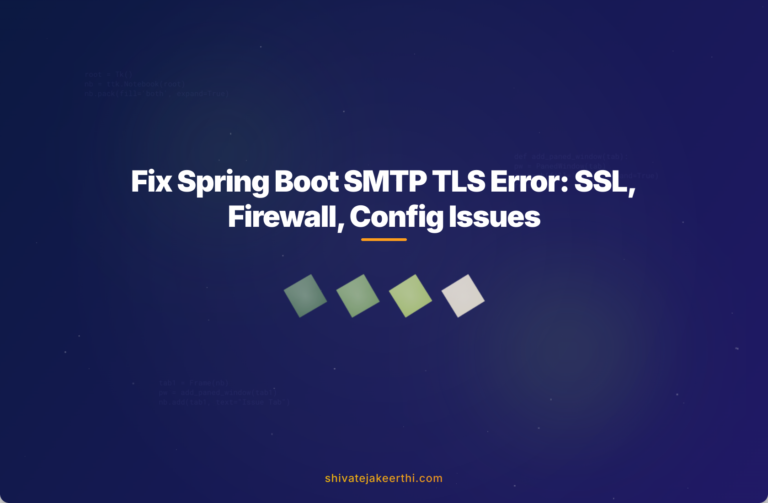When developing applications with Java Spring Boot, email functionality often becomes a crucial feature. It helps notify users, verify accounts, and automate reporting. However, you might encounter issues when your SMTP email starts failing after your server’s IP changes. One common, frustrating error message is “Could not convert socket to TLS“.
This issue typically surfaces when your Spring Boot application attempts to send an email via SMTP from a new IP address. The problem occurs because mail servers often treat new IP addresses cautiously, sometimes requiring extra security configurations on the client’s side. Understanding why this occurs and how you can fix it quickly helps avoid downtime or missing critical emails.
What’s Really Happening: The Background Context
SMTP email sending in a Spring Boot application usually involves using a simple utility class, often named something like MailMessageService. It would typically look similar to this:
@Service
public class MailMessageService {
@Autowired
private JavaMailSender javaMailSender;
public void sendEmail(String to, String subject, String body) {
SimpleMailMessage message = new SimpleMailMessage();
message.setFrom("sender@example.com");
message.setTo(to);
message.setSubject(subject);
message.setText(body);
javaMailSender.send(message);
}
}
Here you configure a few properties to connect to your SMTP server in your application.properties file:
spring.mail.host=smtp.gmail.com
spring.mail.port=587
spring.mail.username=your-email@gmail.com
spring.mail.password=your-password
spring.mail.properties.mail.smtp.auth=true
spring.mail.properties.mail.smtp.starttls.enable=true
spring.mail.properties.mail.smtp.starttls.required=true
This error concerning TLS conversion (“Could not convert socket to TLS”) typically arises when STARTTLS is enabled but there are issues converting a plain connection to a secured (TLS) connection. Failing the TLS handshake causes the SMTP server to abort the send operation.
SMTP and TLS: A Simple Explanation
SMTP (Simple Mail Transfer Protocol) is the standard protocol to exchange emails between mail servers across the Internet. Think of SMTP as the postal service for your emails, routing messages from one mailbox to another.
The TLS (Transport Layer Security) protocol encrypts your SMTP session data, similar to sending your mail via certified mail in a tamper-proof envelope. It prevents unauthorized people from intercepting the emails you’re sending, ensuring confidentiality and integrity.
Without TLS, your emails can be easily intercepted and read by malicious actors. Thus, ensuring a secured SMTP connection using TLS isn’t just beneficial—it’s absolutely necessary.
Common Reasons Why “Could Not Convert Socket to TLS” Occurs
When your Spring application logs this TLS-related error, here’s usually why:
- Incorrect Configuration Settings: A minor typo or incorrect SMTP port selection (often port 587 or 465 for secure connections) triggers errors.
- Issues with SSL/TLS Certificates: Expired, invalid, or misconfigured certificates at either the server or client side disrupt a successful handshake.
- Network or Firewall Restrictions: Firewalls or restrictive network policies might block essential SMTP ports and protocols.
- Compatibility and Dependency Issues: Using outdated versions of JavaMail or Spring-specific dependencies can also be problematic.
Troubleshooting Steps: From Configuration to Resolution
Facing the “Could not convert socket to TLS” error doesn’t have to be frustrating. Instead, systematically walk through these troubleshooting steps:
1. Check & Verify Email Server Settings
First, confirm your SMTP server settings. Make sure the port used (587 or 465 typically) matches the SMTP documentation of your email provider like Gmail, Outlook, or Yahoo. Here’s how it usually looks for Gmail:
- Outgoing mail (SMTP Server): smtp.gmail.com
- Use Authentication: Yes
- Secure Connection: Yes (TLS)
- Port: 587
Here’s Google’s official SMTP documentation for more accuracy.
2. Troubleshoot SSL/TLS Certificate Issues
Check if any changes occurred regarding certificates. If you’re using Java, your JVM maintains a certificate trust-store:
- Verify your JVM trust-store has the right certificates loaded.
- Update your certificates when they’re expired.
You can even bypass TLS verification temporarily (not recommended for production) to test your configuration. For safe testing methods, refer to this helpful Stack Overflow discussion.
3. Resolve Network or Firewall Blocks
Check whether firewall restrictions or network policies are blocking SMTP and/or TLS ports. Use tools like telnet or OpenSSL to verify SMTP connectivity. For example, to manually verify connectivity via command-line, try:
openssl s_client -connect smtp.gmail.com:587 -starttls smtp
This helps pinpoint quickly if firewall rules or network-related issues exist.
4. Update Dependencies and Libraries
Sometimes outdated Java libraries cause unexpected errors. Update dependencies such as spring-boot-starter-mail, javax-mail-api, or jakarta.mail to the latest stable versions. Updating dependencies frequently resolves compatibility issues and introduces enhanced security protocols.
SMTP Email Configuration Best Practices
To prevent future SMTP email issues, consider the following best practices:
- Always use secure email protocols. Choose STARTTLS or SSL explicitly depending on your SMTP provider guidelines.
- Implement proper error-handling mechanisms. Catch and log exceptions for troubleshooting whenever an issue arises.
- Maintain and update configurations regularly. Regular maintenance of configurations, JVM updates, and secure certificates save substantial debugging time down the road.
Exploring Alternative Email Sending Solutions
If troubleshooting is taking too long or you’re looking for scalability, consider alternative solutions:
- Third-party email APIs: Services like SendGrid, Amazon SES, or Mailgun handle server maintenance and security for you.
- Email forwarding or relay services: Internal SMTP relays or email-forwarding services might offer another convenient workaround.
- Separate SMTP servers for sending emails: A dedicated mail server configured specifically to send emails securely might help avoid shared IP or configuration issues.
Resources for Further Reading
For further clarification, the following dependable resources offer valuable insights:
- Wikipedia – SMTP Overview
- Wikipedia – Transport Layer Security (TLS)
- Stack Overflow JavaMail Queries
- Spring Boot Official Email Documentation
- Spring Boot GitHub Issues Tracker
Resolving SMTP SMTP Email Configuration is crucial. Ignored SMTP issues impact user communications negatively, affecting your business trustworthiness. Securing SMTP settings ensures protected communication, leveraging full benefits reliably.
Have you come across any interesting SMTP troubleshooting tips lately? Share how you’ve solved your Spring Boot SMTP email problems—others might benefit from your experience too.



0 Comments